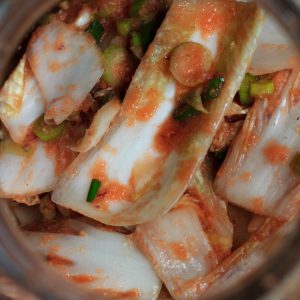Homemade kimchi
1 mason jar 2l
1 large bowl
Chopping knife and board
Blender
1 Large, heavy plate
Cooking gloves
- 2 heads Chinese cabbage
- 1 1/2 cups Salt
- 1 l Water
- 1/2 cup Fish sauce
- Korean chili powder Gochugaru
- 2 tbsp Granulated sugar
- 1 bunch Spring onion
- 5 cloves Garlic
- 5 cm Fresh ginger
- 1 Nashi pear
- 200 g Daikon radish
- 1/4 Red onion
Prep:Remove the outer leaves from the cabbage, quarter it, and cut out the core wedge-shaped. Separate leaves in bunches from the quarters and rinse well in between the leaves in cold water, let them drain well.Fill a large bowl with cold water and dissolve half of the salt in it.Rub remaining salt in between the drained leaves, and massage them vigorously. Soak the salted cabbage bunches for at least five to six hours in the saltwater. It's best to weigh it down with a plate to ensure the cabbage is completely covered. I started the process relatively late in the evening and just let it stand overnight.After the soaking time, the cabbage should be almost rubbery. Remove it from the saltwater and rinse it vigorously under cold, running water at least twice. Let it drain well again. The Marinade:After the salting and soaking process, you can prep the marinade. In a blender, puree garlic, peeled ginger, red onion, peeled and cored pear. Then season with fish sauce, sugar, and chili. I intentionally did not specify the amount of chili; please season to taste. I used 4 heaped teaspoons, which is already quite spicy, but the heat diminishes over time. However, keep in mind that ginger also contributes to the spiciness.Wash the spring onions and cut them into fine rings. Peel the radish and cut it into fine julienne. Sterilizing:To sterilize the jar, preheat the oven to 100°C, wash the jar thoroughly, and dry it. Remove the lid with the rubber ring and place the jar along with the lid upright in the hot oven. Leave it in the oven for 20 minutes. Simply boil the rubber ring in water for about 10 minutes. Do not touch the inside of the jar after sterilizing and only use clean utensils. If your kimchi starts to rot, it is most likely because the tools or the jar were not properly cleaned. Marinating the Cabbage:Evenly coat the cabbage with the marinade, which works best by massaging it with your hands, really go in there in between the leaves. Don't forget to wear gloves!Mix in the radish with spring onions, then transfer the cabbage to the sterilized mason jar and seal it. Essentially the cabbage is ready; however, its typical sour, salty taste develops through fermentation. Fermenting:Admittedly, this is an improvised setup, real pros have an actual kimchi fridge and kimchi jars that regulate the fermentation. But, any dark place and room temperature will do for us this one time!Leave the jar standing, airing the jar every eight hours. Fermentation produces gases that need to be released regularly, as too much pressure can build up, and the jar could potentially burst – but you're probably familiar with this principle from young wine.Leave the jar like this for three days, then it's ready. If you like it more sour, just let it ferment longer; it's really up to you. Once it suits your taste, seal the jar and store it in your fridge to stop fermentation. This way, it will last for several months – unless you eat it up all at once right away because it simply tastes so delicious.
